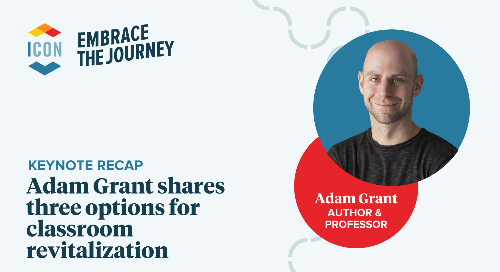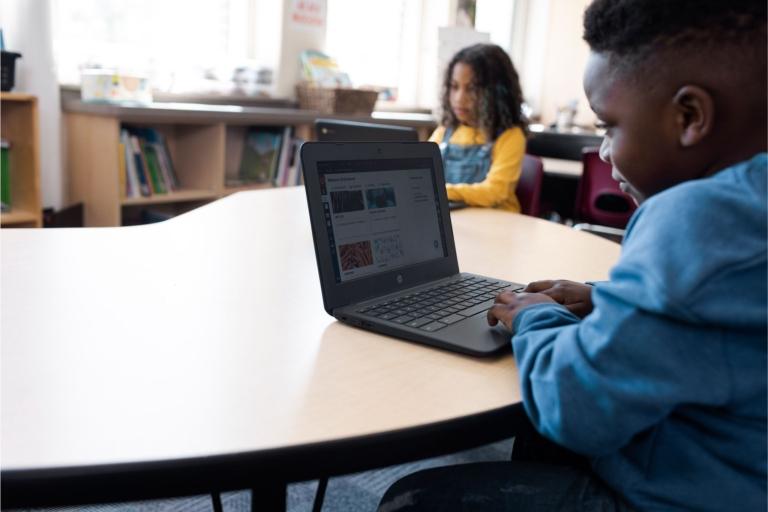
It’s not merely sleight of hand or misdirection when it comes to the motivational magic of New York Times bestselling author, speaker, former magician, and beloved Wharton professor, Adam Grant. When examining innovative ways of teaching or sharing his often-viral, insightful pearls of advice on his social media channels, Adam is quick to attribute his students and colleagues for the lessons he has been taught over the years.
Studying the biographies and memorizing specific facts for some 215 students prior to the first day of class, for example, was no magic act or parlor trick. It was simply an illustration of how an instructor can truly care about each student and understand where they came from. A skill that proved invaluable as he cultivated that particular course curriculum.
While a magician is traditionally sworn to never fully reveal the secrets behind their tricks, as one of the keynote speakers for InstructureCon 2022, Adam took the time to reveal the secrets behind some of his insightful, inspiring classroom magic. In an interview conducted by Shiren Vijiasingam, Instructure’s Chief Product Officer, Adam shared his insights on many topics sure to spark conversation among educators, including three options for revitalizing your classroom, such as remedies for teacher burnout, seeking unique ways to connect with students, and creating an evidence-based support structure.
Self-care can alleviate educator burnout
Teacher burnout is a very real struggle. In fact, it’s been reported that 55% of educators are considering leaving the profession earlier than planned. Educators languished during the pandemic and are still experiencing the fatigue associated with a virtual classroom devoid of in-person camaraderie.
Through his research for the book Give and Take, Adam discovered that teachers tend to be givers. Because teachers are known to be givers. “Essentially, there is no variance,” he said. “We didn’t find any teachers who were takers, who are all about, ‘What can you do for me?’” Because of that selfless, giving tendency, however, teachers tend to sacrifice themselves for their students, “helping one student, but actually disadvantaging the whole class,” ultimately burning out.
When balancing self-care with concern for others, teachers facing impending burnout were able to say, “‘Okay, I’m going to be thoughtful about helping in ways that are going to have the most impact. So I’m going to prioritize what’s good for the group over the immediate needs of the individual,’” Adam said. “‘I’m going to try to help in ways that I’m actually good at and then refer to another specialist or an expert if this is not my wheelhouse, instead of spinning my wheels. I’m also going to block out time to sleep, to exercise, and to get my grading done.’”
Adam went on to outline three additional items to help move out of that languishing state:
- Moments of mastery: seek out ways to build relationships with every student.
- Mindfulness: focus on one thing by specifically blocking out time.
- Mattering: know that your work as an educator makes a difference in other people’s lives.
Finding connections elicits engagement with students
Seeking out ways to connect with students will not only prompt better classroom engagement, but it will also allow students to find commonalities among their classmates which, in turn, will improve the overall course experience.
In the example of his 215 students, Adam related how he was hyper-focused on better connecting with all those students despite the course only being one-week long. By accessing each student’s biography before the beginning of the course, he was able to accelerate the process of getting to know each individual.
By making this extra, concerted effort, Adam found that it raised the bar in the classroom. “I was able to say to them, ‘Listen, I didn't do this as a parlor trick. This isn't me as a magician. Granted I'm using some of the habits that I practice as a magician to memorize things, but this isn't me just standing up here to put on a show and try to impress you. What I'm trying to do is make it clear to you that although we only have a week together, I care about getting to know each of you, and that starts with knowing a little bit about where you came from and what your perspective might be and what you have to contribute to the class.’”
In another example that connected classmates to one another, Adam collected personal information from a class of undergrad students like favorite authors, favorite TED talks, podcasts, etc… He then compiled that information into a classroom portrait highlighting the favorite thinkers, authors, favorite shows, and more. “It allowed them to bond with each other around those common interests and they started bringing those into class and we used those as examples.”
Find confidence in an evidence-based support structure
When building out a curriculum, especially in this hybrid world where some students are sitting in classroom desks while others are tuning in remotely, educators should seek feedback from thoughtful critics who can be trusted to share the truth while not worrying about bruising egos. “They’re trying to help your learning and growth,” Adam said.
“I think the most important message you can send, whether you're an administrator talking to your team and colleagues, or whether you're a teacher talking to students, is that when people have constructive criticism to give, they often feel torn between honesty and loyalty. Well, actually there's no conflict between the two. In my worldview, honesty is the highest expression of loyalty. The more candid you are with me, the more I will appreciate your input. I think that if this becomes a norm, it's a lot easier. So I've had teachers where we sit in on each other's classes and then we give each other notes afterward.”
Adam continued to expound saying that “if eight people are giving you suggestions, you know you have to rise to the occasion, as opposed to ... when one person said they didn't like something, nobody else mentioned it. When five different people pointed out the same flaw in my argument, I've got to listen to that. It's probably my favorite way to learn.”
When adapting classrooms and coursework in this new hybrid, post-pandemic world, educators throughout the K-12 and higher education worlds can all lean on Adam Grant’s three secret magic tricks. Remember that self-care is an ideal way to avoid teacher burnout, seek out clever ways to connect with students and turn to colleagues to create an evidence-based support structure.
To view the entire keynote and all the InstructureCon 2022 breakout sessions, click here.
Related Content
 Teaching-With-Tech-10-Benefits.jpg
Teaching-With-Tech-10-Benefits.jpgBlogs
 untitled_design.jpg
untitled_design.jpgBlogs

Blogs